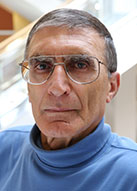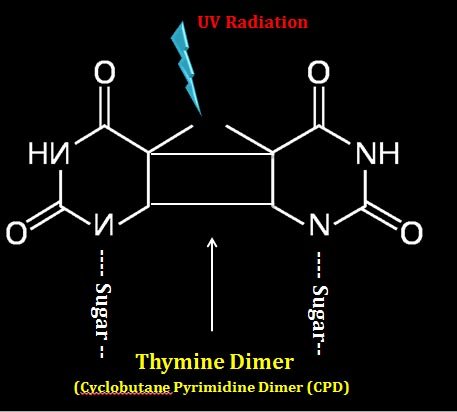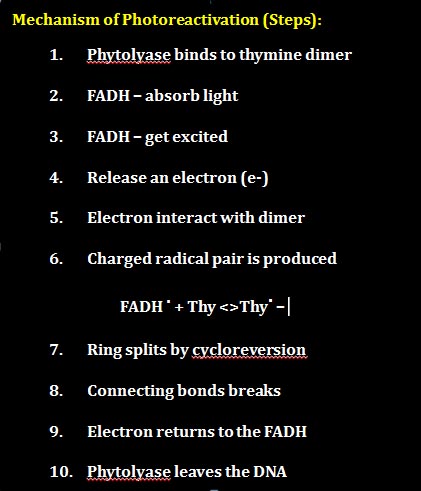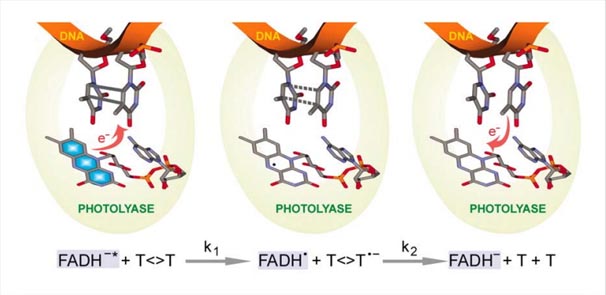Science is beautiful when it makes simple explanations of phenomena or
connections between different observations.
Stephen W. Hawking, 2011
What is Photoreactivation?
Photoreactivation is a type of DNA repair mechanism present in prokaryotes, archaea and in many eukaryotes. It is the recovery of ultraviolet irradiated damages of DNA by visible light. As the name suggests, it is a light dependent process. In this DNA repair method cells recovers its DNA after UV exposure induced damages. The UV light is lethal to cellular DNA since it induces structural lesions in the DNA by the formation of pyrimidine dimer.
Photoreactivation process removes the pyrimidine dimers without altering other nucleotides in the DNA by using energy obtained from visible light. Photoreactivation is the first discovered DNA repair mechanism in the cell. Major credits for the discovery of Photoreactivation goes to Professor Aziz Sancar for which he was shared the 2015 Nobel Prize in chemistry along with Thomas Lindhal and Paul Modrich.

Aziz Sancar
How UV radiation induces pyrimidine dimers in the DNA?

The exposure of DNA with ultraviolet radiation causes pyrimidine dimer formation. Among the different types of pyrimidine dimers, the thymine dimer is the most common one. In UV induced thymine dimer formation, the thymine residues adjacently situated in the DNA strand are covalently bonded to each other which causes a structural lesion in the DNA. Thymine dimer is also called as cyclobutane photodimer or CPD because it structurally resembles cyclobutane nucleus.
When UV light hit the DNA, the double bonds which present between C5 and C6 of adjacent thymine residues breaks and to balance the valency of carbon, two covalent bonds are formed between these residues. Thymine dimers induces a bulge in the DNA and as a result, the normal conformational symmetry of DNA is lost with this DNA lesion
Discovery of Photoreactivation process:
In 1920s, Herman Muller discovered that X-rays can induce mutations and can kill the cells. Later on, other types of radiations, including ultraviolet rays were also shown to affect cell viability and mutation levels. In 1940’s Albert Kelner with simple experiments discovered that the UV induced cellular damages can be recovered by treating the cells with visible light.
He called this healing process by light as Photoreactivation, since it was a light depended re-activation or recovery of cells. Then a few years, later, Renato Dulbecco suggested that Photoreactivation may be an enzymatic process depended on visible light. However he was not able to prove his theory experimentally. Immediately after this, Stan Rupert proved Dulbecco theory of enzymatic Photoreactivation and he named the enzyme as Photolyase for the first time.
The discovery of photolyase was very remarkable in the scientific community because for the first time it proved the existence of such an enzymatic DNA repair mechanism in the cell. In 1978, Professor Aziz Sankar cloned and purified the photolyase enzyme of E. coli for the first time. Sancar was at the time a Ph.D. student of Professor Stan Rupert, but instead of continuing to characterize the photolyase, Sancar wrote his PhD dissertation and graduated. After four year, in 1983, Sancar returned to his original work of Photolyase enzyme and he characterized the enzyme and also explained the detailed molecular mechanism of photoreactivation process by photolyase and visible light.
Enzyme Photolyase and Mechanism of Photoreactivation by Photolyase

Photolyase is a flavoprotein and it contains two chromophores which absorb energy from visible light. The chromophores act as the catalytic cofactors. The two chromophores of photolyase are:
Ø A fully reduced Flavin Adenine Dinucleotide or (FADH-)
Ø Folate group
The fully reduced FADH – is very essential for the catalytic properties of the photolyase enzyme. Photylyase enzyme can absorb light and get activated. The light activated photolyase enzyme splits the thymine dimer through a local free radical mechanism by a transient electron transfer method. First the photolyase enzyme recognizes the thymine dimer lesion and binds to it.
The enzyme then absorbs visible light at 300 – 500 nm (near blue region). As result of light absorption, the FADH – co-factor get excited and elevated to a higher energy state. The excited FADH- then transfers an electron to the thymine dimer. This electron interacts with the thymine dimer and as a result of this interaction a charged separated radical pair (FADH˳ + Thy <> Thy ˳ -) is produced.
The unstable radical pair suddenly splits and thus the connecting two covalent bonds between thymine residues break. Once the connecting bonds breaks and the thymine residues are recovered, the electron is returned to the FADH-. Then the photolyase enzyme leaves the DNA and the normal conformational symmetry of DNA is regained. This is how photolyase enzyme removes the pyrimidine dimer from the DNA in a light depended fashion.

Significance of Photoreactivation process:
Photoreactivation was the first DNA repair mechanism identified. It is a direct reversal method of DNA repair in the cell. In Photoreactivation process, the enzyme does not require the assistance of the template strand and there is no removals of nucleotides are involved. Photoreactivation is not a universal DNA repair mechanism.
Photoreactivation mechanism is present in Bacteria, archaebacteria, plants and many animals. This method of DNA repair is completely absent in placental animals including human. Placental animals including human beings uses nucleotide excision repair (NER) to remove pyrimidine dimers from the DNA.
<<Back to Molecular Biology Notes
Download the PPT of this Topic…
DNA Repair Mechanisms Part 2: Photoreactivation Repair of DNA PPT
